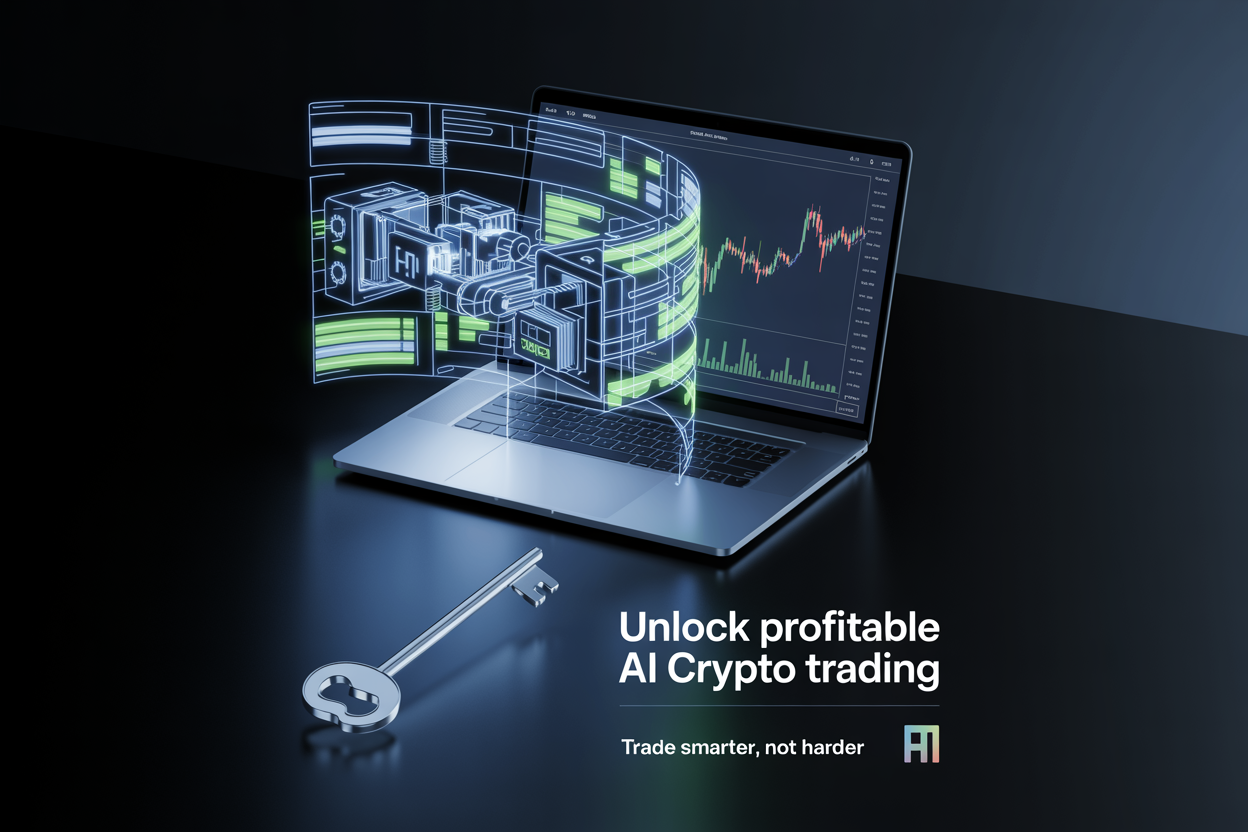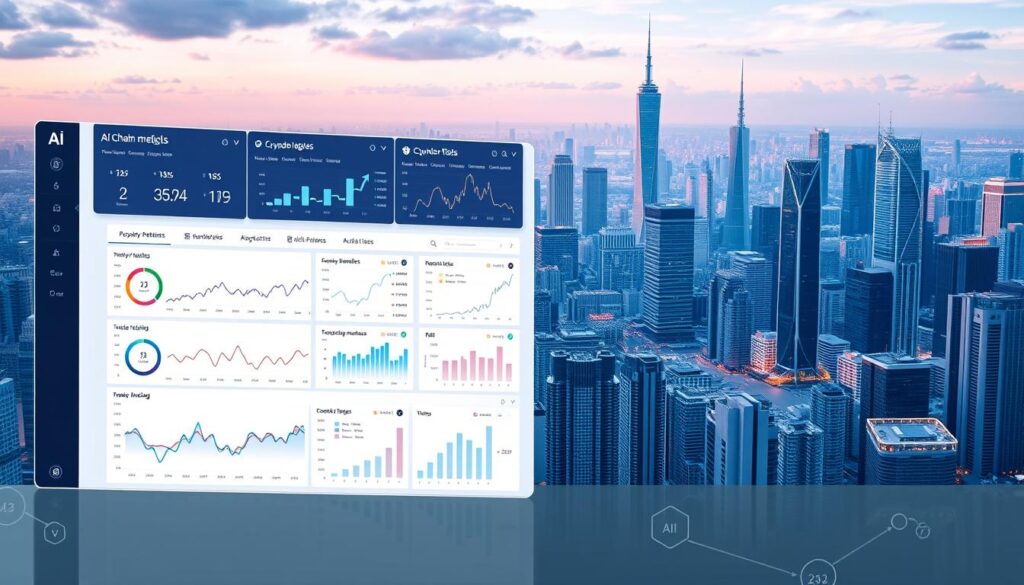Now Reading: Unlock Profitable AI Crypto Trading with This Strategy
- 01
Unlock Profitable AI Crypto Trading with This Strategy
Unlock Profitable AI Crypto Trading with This Strategy

The world of cryptocurrency trading is changing fast. One big change is the use of Artificial Intelligence (AI) in trading strategies. AI helps traders make better choices, thanks to data-driven insights.

An AI-powered crypto trading method lets traders look at lots of market data. They can spot patterns and predict trends better. This makes trading more profitable and safer than old ways.
Key Takeaways
- AI integration in crypto trading enhances decision-making.
- Data-driven insights improve trading accuracy.
- AI-powered trading reduces associated risks.
- Traders can analyze vast amounts of market data.
- AI helps in identifying patterns and predicting trends.
The Current State of Cryptocurrency Markets
The cryptocurrency market is known for its quick changes. These changes offer both chances and challenges for traders. Market volatility is a key feature that can lead to big wins or losses.
Market Volatility and Trading Opportunities
High volatility in cryptocurrency markets opens up many trading chances. Traders can make profits from the fluctuations. But, it needs a deep understanding of market dynamics and a strong trading strategy.
Why Traditional Trading Methods Fall Short
Traditional trading methods often can’t keep up with cryptocurrency markets. The lack of a cryptocurrency trading algorithm that can adapt quickly is a big problem. Advanced strategies, like AI-driven trading, are needed to succeed in these markets.
What Makes AI Crypto Trading Strategy Different
The use of artificial intelligence in crypto trading has changed the game. It brings a new level of sophistication to trading. This allows traders to make better decisions.
The Power of Algorithmic Decision-Making
Algorithmic decision-making is key in AI crypto trading. It uses complex algorithms to quickly analyze huge amounts of data. This helps traders spot patterns that humans might miss.
This leads to faster and more accurate trading decisions. It gives traders an edge in the market.
How Machine Learning Transforms Market Analysis
Machine learning changes market analysis by letting systems learn from past data. They get better at predicting over time. This makes AI trading systems more effective in changing markets.
Advantages Over Human Traders
AI crypto trading strategies have big advantages over human traders. They can handle information faster and on a larger scale. They also work non-stop without getting tired.
They make decisions based on data, not emotions. This makes AI trading systems great for the fast and unpredictable crypto market.
Essential Components of a Successful AI Trading System
To create a good automated trading system, you need to think about a few key things. A well-made AI trading system is key for dealing with the complex world of cryptocurrency markets.
Data Collection Infrastructure
A strong data collection infrastructure is crucial for getting and using market data for AI trading. This means setting up APIs to get real-time and past data from different exchanges. You also need a good way to store this data.
Algorithm Development Framework
The algorithm development framework is the core of any AI trading system. It’s about picking the right machine learning models, testing strategies, and fine-tuning them for the best results. A flexible framework helps adapt to market changes easily.
Execution and Monitoring Tools
Execution and monitoring tools are key for turning trading signals into real trades and checking how well the system is doing. These tools help manage risk, adjust to market ups and downs, and keep the trading strategy on track.
By focusing on these key parts, traders can make a full AI trading system. This system can keep up with the fast-changing world of cryptocurrency.
Setting Up Your AI Crypto Trading Foundation
A solid AI crypto trading system begins with key elements. You must focus on hardware, software, and API connections. These are the building blocks of a successful trading setup.
Required Hardware Specifications
The hardware is the core of your AI crypto trading system. You’ll need a computer with a multi-core processor. It should have at least 16 GB of RAM and ample storage, preferably an SSD for quick data access.
For bigger tasks or larger data sets, think about cloud-based services or high-performance computing clusters.
Software Tools and Platforms
Choosing the right software is key for your AI trading algorithms. Use Python with TensorFlow or PyTorch for machine learning. Also, look at blockchain trading platforms for tools to develop and run strategies.
Make sure your platform supports backtesting and has strong risk management features.
API Connections to Exchanges
To trade, your AI system must connect to exchanges through API connections. Most big exchanges offer APIs. When setting up API connections, keep security in mind.
Use secure keys and two-factor authentication. Also, watch out for rate limits to avoid restrictions on your API keys.
- Choose exchanges with robust API support
- Implement secure API key management
- Monitor API rate limits to avoid restrictions
Data Collection for Smart Trading Algorithms
The success of AI crypto trading algorithms depends on good data collection. It’s important to gather a wide range of high-quality data. This data helps train models to predict market trends and make smart trading choices.
Price and Volume Data Sources
Price and volume data are key for any trading algorithm. You can get this data from many cryptocurrency exchanges through APIs or from data providers. Reliable historical data is vital for testing trading strategies and making sure they work well.
Market Sentiment Indicators
Market sentiment indicators show how the market feels. They help algorithms adjust their plans. These indicators come from social media, news, and other market signals. Natural Language Processing (NLP) is used to understand text and figure out market mood.
On-Chain Metrics and Their Importance
On-chain metrics give a special look at market activity. They analyze data straight from the blockchain. Metrics like transaction volume and network congestion offer insights into market trends. Adding on-chain data boosts AI trading algorithms’ predictive power.
By using all these data types, AI crypto trading algorithms get a full view of the market. This leads to more accurate predictions and smarter trading choices.
Building Your First AI Crypto Trading Strategy
Creating an effective AI crypto trading strategy needs a detailed plan. It must have clear goals, strong machine learning models, and solid validation methods. This approach is key to handling the complex and unpredictable cryptocurrency market.
Defining Clear Trading Objectives
The first step is to set clear trading objectives. You need to decide what you aim to achieve, like making profits, cutting losses, or getting a certain return. Having clear goals helps shape your strategy and measure its success. For more on making a crypto trading bot, check out Solulab’s guide.
Selecting Appropriate Machine Learning Models
The right machine learning models are crucial for your AI crypto trading strategy. Different models work better for different trading styles and market conditions.
Supervised Learning Approaches
Supervised learning trains models on past data to forecast future market trends. It’s good for spotting patterns and trends in cryptocurrency prices.
Unsupervised Learning Applications
Unsupervised learning methods, like clustering, find hidden patterns in data without labels. They offer insights into market structures and potential trading chances.
Strategy Validation Methods
Validating your AI crypto trading strategy is vital. It ensures the strategy works well and is reliable. You test it on past data and check its performance with various metrics. Walk-forward optimization and cross-validation help see if the strategy will succeed in the future.

Implementing Artificial Intelligence Trading Techniques
AI trading is changing how we look at and interact with financial markets. It uses advanced algorithms and machine learning to help traders make better choices. This leads to more precise trading.
Technical Indicator-Based Strategies
Technical indicators are key in traditional trading. AI makes them even more powerful by finding hidden patterns. Some important indicators include:
- Moving Averages
- Relative Strength Index (RSI)
- Bollinger Bands
By adding these indicators to AI models, traders can create robust trading strategies. These strategies adjust to market changes.
Natural Language Processing for News Analysis
NLP is a part of AI that works with human language. In trading, it helps analyze news and social media to understand market feelings. This info helps traders make better choices.
Using NLP in trading offers several benefits:
- Sentiment analysis
- Event-driven trading
- Enhanced market awareness
Deep Learning for Price Pattern Recognition
Deep learning uses neural networks to analyze complex data. In trading, it spots patterns in price data that hint at future trends. By training on past data, traders can predict market moves.
Deep learning’s advantages in trading are:
- Pattern recognition
- Predictive accuracy
- Adaptability to changing markets
Risk Management in Cryptocurrency Trading Algorithm
Effective risk management is key for success in cryptocurrency trading. The markets are very volatile. This makes it important for traders to have strong strategies to make more money and lose less.
Risk management in cryptocurrency trading includes several important parts. These are position sizing, stop-loss, and adjusting for volatility. Together, they help traders deal with the unpredictable nature of cryptocurrency markets.
Position Sizing Formulas
Position sizing is a big part of risk management. It decides how much money to put into a trade. A good position sizing formula helps manage risk and avoid big losses. By adjusting the size of their positions, traders can handle volatile markets better.
Automated Stop-Loss Implementation
An automated stop-loss is a crucial tool in risk management. It lets traders set a price where their position will close automatically. This limits losses if the market goes against them. It also reduces stress and prevents big losses.
Volatility-Based Risk Adjustments
Volatility-based risk adjustments mean changing trading strategies based on market volatility. By adjusting risk based on market conditions, traders can manage their risk better. This improves their chances of success in cryptocurrency markets.
By using these risk management strategies, cryptocurrency traders can increase their chances of long-term success.
Backtesting Your Machine Learning Investment Strategy
Backtesting is key for checking a machine learning investment strategy‘s worth. It tests the strategy on past data to see how it might do in real markets. This helps spot any problems before it’s too late.

Historical Data Testing Methodologies
There are many ways to backtest a strategy with historical data. One method is walk-forward optimization. Here, the model is trained on some data and then tested on more. This is done many times to make sure the model is strong.
Another method is cross-validation, like k-fold cross-validation. It checks how well the model does on data it hasn’t seen before. This helps avoid overfitting and gives a clearer picture of the model’s performance.
Avoiding Overfitting Problems
Overfitting is a big problem in machine learning. It happens when a model learns too much from the training data and doesn’t do well with new data. To stop this, use regularization and early stopping. Regularization adds a penalty to the loss function to keep weights small. Early stopping stops training when the model’s performance on unseen data starts to drop.
Performance Metrics That Matter
When backtesting, it’s important to use the right metrics to judge the strategy’s success. Key metrics include return on investment (ROI), Sharpe ratio, and drawdown. These show how profitable the strategy is, its risk-adjusted returns, and its biggest losses.
By backtesting a machine learning strategy well and using the right metrics, investors can trust their model’s performance. This helps them make better investment choices.
Popular Blockchain Trading Platforms with AI Capabilities
AI-powered blockchain trading platforms give traders an edge in the fast-changing cryptocurrency market. They use artificial intelligence to spot trends, forecast prices, and make trades better than old methods.
The need for advanced trading tools has sparked the creation of many blockchain trading platforms with AI. These platforms help a variety of traders, from newbies to pros.
Ready-to-Use Solutions for Beginners
For those new to trading cryptocurrencies, there are easy-to-use platforms with AI help. These platforms offer:
- Simplified interfaces for easy navigation
- Automated trading strategies based on AI analysis
- Real-time market data and insights
For example, Coinbase and Binance have user-friendly interfaces and AI trading options for beginners.
Advanced Platforms for Experienced Traders
For seasoned traders, there are more advanced platforms with top-notch AI features. These platforms offer:
- Customizable trading algorithms
- Advanced technical analysis tools
- Integration with multiple exchanges for diversified trading
Platforms like QuantConnect and Alpaca are favorites among experienced traders. They offer advanced features and AI-driven trading strategies.
Step-by-Step Implementation of an Automated Trading System
To lead in the cryptocurrency market, setting up an automated trading system is key. It involves several important steps. These steps help you craft a detailed trading plan.
Setting Up Your Development Environment
The first step is setting up your development environment. Choose a programming language like Python. It’s popular for its vast libraries and ease of use. Pick a good IDE, like PyCharm or Visual Studio Code.
Having a well-configured environment is vital for easy development.
Coding Your First Trading Algorithm
With your environment ready, start coding your first trading algorithm. First, define your trading strategy. This includes the indicators and signals for trades. Use historical data to test your algorithm.
Connecting to Exchange APIs Safely
After coding, connect to exchange APIs safely. Most exchanges offer APIs for trading. It’s important to keep API keys secure to protect your accounts.
Use specific libraries for your exchange, like CCXT. Always check your API connections to avoid problems.
By following these steps, you can build a strong automated trading system. It will work well in the cryptocurrency market.
Optimizing Your AI-Powered Crypto Trading Performance
To boost AI-powered crypto trading, you need to work on many parts of your system. It’s key to focus on areas that really matter for better results.
Fine-Tuning Algorithm Parameters
Adjusting your algorithm’s settings is crucial. It helps get better returns while keeping risks low. Think about these things:
- Change how sensitive your indicators are to market changes
- Balance the weight of different market signals
- Make your algorithm’s decisions smarter
By tweaking these settings, you can make your AI trading better.
Adapting to Changing Market Conditions
It’s important to keep up with market changes. Markets shift fast because of many reasons. To stay on top, do this:
- Keep an eye on market trends and feelings
- Update your algorithms for new market moves
- Use strategies that can handle different market situations
Being flexible is key for lasting success in trading.
Performance Monitoring and Improvement
Watching and improving your trading performance is ongoing. Traders should check their system’s results often. Look at these important metrics:
- Return on investment (ROI)
- Risk-adjusted returns
- Drawdowns and how fast you recover

By working on these areas and always improving, traders can make their AI crypto trading better. This helps reach their investment goals.
Real-World Case Studies of Digital Asset Trading Strategies
The world of digital asset trading has seen a big rise in successful strategies. Both institutions and individual traders have found ways to make money. This section looks at some case studies that show how good trading strategies can work in the cryptocurrency market.
Institutional Success Stories
Institutional traders have used advanced strategies to get great results. For example, some hedge funds have done better than traditional assets with long-term crypto investment strategies. They use smart algorithms and machine learning to find good trading chances.
Individual Trader Implementations
Individual traders have also found success with digital asset trading strategies. They often mix technical analysis with market sentiment indicators. By being disciplined and managing risks well, they can make a lot of money. Their success comes from being able to adjust to market changes and improve their strategies.
Common Pitfalls in Smart Trading Algorithms
Smart trading algorithms have great potential but face several challenges. These include technical, market, and regulatory issues. Traders need to know these pitfalls to improve their trading.
Technical Implementation Challenges
Implementing smart trading algorithms is complex. It involves ensuring robust data feeds and managing latency. Traders also face the risk of overfitting, where algorithms work well on past data but fail in real-time.
Market-Specific Risks
Smart trading algorithms are also at risk from market volatility and liquidity issues. These can greatly affect how well the algorithm performs. Proper risk management strategies are key to handling these risks.
Regulatory Considerations
Traders must also deal with the complex rules around algorithmic trading. This includes following rules against market manipulation and being transparent in trading. Breaking these rules can lead to big fines and harm to reputation.
Knowing these common pitfalls helps traders prepare better. They can then develop and use smart trading algorithms that reduce risks and increase profits.
Advanced Techniques for Experienced AI Traders
Experienced AI traders are always looking for new ways to succeed in the fast-paced cryptocurrency market. They use advanced techniques that rely on the latest in artificial intelligence.
Reinforcement Learning Applications
Reinforcement learning helps AI traders learn through trial and error. They make better trades over time. This way, they don’t need to be told how to trade.
This method lets AI systems adjust to market changes. It’s great for traders who want to improve their strategies.
Ensemble Methods for Improved Accuracy
Ensemble methods combine several AI models to make trading predictions more accurate. By using different models together, traders can avoid relying on just one strategy. This boosts their overall performance.
It lets traders use the best parts of each model. This leads to stronger and more reliable trading choices.

Adaptive Algorithms for Market Shifts
Adaptive algorithms adjust to market changes in real-time. They keep trading strategies working, even when the market is unpredictable. These algorithms can spot changes in market trends and change their approach.
By adding adaptive algorithms to their systems, experienced AI traders can stay on top. They can also increase their profits.
The Future of AI in Cryptocurrency Markets
AI is changing how we trade in cryptocurrency markets. As AI gets better, it will give traders new tools for making smart choices. This will help them analyze and decide better.
AI’s future in these markets looks bright. It will help create better predictive models. These models will look at lots of data to guess market trends. This could make trading more profitable for everyone.
AI will also improve how we manage risks. It will help traders avoid big losses. As the market grows, AI will play a bigger role. It will make trading faster and more efficient.
Using AI, traders can find new chances in the crypto world. AI will be key in shaping the future of these markets. It will help them grow and succeed.
FAQ
What is an AI crypto trading strategy?
An AI crypto trading strategy uses artificial intelligence and machine learning. It analyzes market data, predicts trends, and makes trades in the crypto market.
How does AI improve crypto trading?
AI makes crypto trading better by quickly analyzing big data. It spots patterns and predicts trends. This helps traders make smarter choices.
What are the essential components of a successful AI trading system?
A good AI trading system needs a strong data collection setup. It also needs advanced algorithms and reliable tools to monitor and execute trades.
Can I use AI crypto trading strategies without prior experience?
You can start with AI crypto trading without experience. But, it’s important to know the basics of trading and AI. This helps avoid big losses.
How do I backtest my machine learning investment strategy?
Backtesting uses past data to check your strategy’s performance. It’s key to use different data, avoid overfitting, and watch important metrics.
What are some common pitfalls in smart trading algorithms?
Pitfalls include technical issues, market risks, and legal hurdles. Knowing these risks helps you avoid them.
How can I optimize my AI-powered crypto trading performance?
To improve, tweak your algorithm, adjust to market changes, and keep improving your strategy. This boosts your performance.
Are there any ready-to-use AI crypto trading platforms?
Yes, many blockchain trading platforms offer AI tools. They help both new and experienced traders use AI strategies easily.
What is the role of risk management in AI crypto trading?
Risk management is key in AI crypto trading. It includes setting trade sizes, using stop-loss, and adjusting for volatility. These steps protect your investments.
Can AI trading strategies be used for other financial markets beyond crypto?
Yes, AI strategies work in other markets like stocks, forex, and commodities. AI and machine learning are versatile, not just for crypto.















